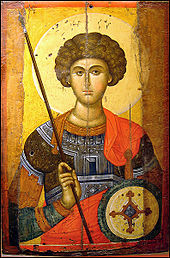St George and St Erkenwald

St George
Martyr. Patron saint of England, Venice, Genoa, Portugal and Catalonia. He is highly revered in Germany, Russia, Ethiopia and a patron of soldiers, knights, archers and armourers.
This third century saint was one of the most famous of the early martyrs. There is no historical evidence for his life. According to the writings of St Jerome and the Gregorian Sacramentary, he was a Palestinian soldier who was martyred for his faith at Lydda, during the persecutions of Diocletian and Maximian.
From the earliest times churches were dedicated to him in Jerusalem. Numerous icons of him portrayed him as a powerful helper against evil powers affecting individual lives.
The most famous legend of St George and the Dragon became immensely popular in the west through the Golden Legend, translated and printed by Caxton. This tells of a dragon which terrorised the whole country, killing anyone who came near. For many years the monster was placated with offerings of sheep, and the occasional human being, chosen by lot. One day the king's daughter was picked as the dragon's next victim. She went to her fate, dressed as a bride, but George followed her, attacked the dragon and held it captive, using the princess's girdle. George told the people not to be afraid. He said if they believed in Jesus and were baptised, the dragon would be gone. The king and the people agreed and 15,000 were baptised then and there. George then killed the dragon. He refused any reward, simply asking the king to build churches and care for the poor.
The cult of St George has been known in England and Ireland since the 7th century. During the Crusades there was said to be a vision of the saint at the siege of Antioch, before the defeat of the Saracens. At the Synod of Oxford he was made the special patron of chivalry. Under King Edward III he became England's national patron the king founded the Order of the Garter under his patronage. In 1348 St George's Chapel at Windsor was founded. In 1415, this day was made a special festival throughout the country.
St George's flag, the red cross on a white background is so widespread it is often regarded as a general Christian banner.
There are many paintings of St George around the world. Two famous ones are Ucelo's in the National Gallery, London, and Raphael's in the National Gallery of Washington. There are also murals at the cathedral of Clermont-Ferrand and the chapel of San Georgio at Padua. There are churches dedicated to St George in Rome, Constantinople, Venice and Verona. In England more than 160 ancient churches and several modern ones are also named after him.
St Erkenwald
Bishop of London. This seventh century saint was London's most important religious figure for many centuries. His diocese extended over Essex and Middlesex. Reputed to be of royal blood, he founded the monasteries of Chertsey in Surrey and Barking in Essex. He ruled Chertsey while his sister, St Ethleburga was abbess of Barking.
During his lifetime he had a great reputation for holiness. He helped to bring about reconciliation between Wilfred and Theodore. He died at Barking on this day in 693 and was buried in St Paul's Cathedral.
His relics survived the fire of 1087. His shrine become more ornate each century as it was endowed by London canons and merchants. It was a popular place of pilgrimage until it was destroyed during the Reformation.












